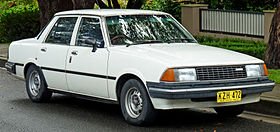Mazda Capella 626 Second Generation CB
 |
|
| Also called | Mazda 626 Mazda Montrose |
|---|---|
| Production | 1978—1982 |
| Assembly | Hiroshima, Japan Auckland, New Zealand |
| Body style | 4-door sedan 2-door coupé |
| Layout | FR layout |
| Engine | 1.6 L NA I4 1.8 L VC I4 2.0 L MA I4 |
| Transmission | 4/5-speed manual 3-speed automatic |
| Wheelbase | 2,510 mm (98.8 in) |
| Length | 4,260–4,300 mm (167.7–169.3 in) |
| Width | 1,580–1,660 mm (62.2–65.4 in) |
| Height | 1,395 mm (54.9 in) (coupe) 1,420 mm (55.9 in) (sedan) |
| Curb weight | 975–1,080 kg (2,150–2,381 lb) |
The second generation rear-wheel drive Capella was available between 1978 and 1982, in both sedan and coupe forms. It was known on export markets as the 626, with the exception of the United Kingdom, where it was called the Mazda Montrose, the name was changed to honour the local Mazda dealership in Montrose. It began appearing in 1978, although the model's introduction to most markets was delayed until 1979. Early models had two slightly different frontal treatments, one with a more pronounced sloping grille to denote some models, particularly on the Japanese domestic market. A bolder front and rear facelift, though similar in appearance, was done for 1981 but this model was not sold in the UK. It was, however offered in Europe and this and later generations were particularly popular in Germany.
The coupé and sedan were mechanically identical, with front MacPherson struts and a solid axle in back mounted on four links and riding on coil springs, either a five-speed manual or three-speed automatic transmission and recirculating ball steering. The CB also featured a split-folding rear seat. In Japan, the Capella came with 1.6, 1.8, or 2.0 litre engines (the 2.0 only being introduced in March 1979). All had twin-barrel carburettors and produced 90, 100, and 110 PS JIS (66, 74, or 81 kW). The higher equipped versions received the larger US bumpers and were thus somewhat longer overall.
The Mazda 626 badge was used for the first time in some markets. The 626 was typically fitted with the 1.6 or 2 litre version of the Mazda F/MA, which produced from 75 to 90 PS (55 to 66 kW). The 626 was facelifted in November 1980, with the update bringing flush-fitting headlamps and a new grille insert.The grille was lengthened slightly to remove the body-colored gap between the headlamps and grille on the original model. It was also reduced in height so that the grille and headlamps formed a single "band" across the front-end.
New Zealand
This generation was also assembled in New Zealand in three versions - four-speed manual base, three-speed automatic mid range and five-speed manual "Limited". Facelift models were much the same but some had velour upholstery and tinted glass.
In 1982, Mazda NZ offered a locally assembled limited edition model called the Anniversary to mark 10 years of local build. Based on the Limited, this model had larger US-style bumpers, additional driving lights in the grille, a standard AM radio (this was a year before FM stereo radio was introduced in NZ) plus alloy wheels and unique velour upholstery. This was also the first NZ-built Mazda to have a laminated windscreen as standard.
Technical
-
Model Engine Power Torque World 1,586 cc NA I4 75 PS (55 kW) 12.2 kg·m (120 N·m; 88 lb·ft) 1,970 cc MA I4 90 PS (66 kW) 15.9 kg·m (156 N·m; 115 lb·ft) Japan 1,586 cc NA I4 90 PS (66 kW) 13.0 kg·m (127 N·m; 94 lb·ft) 1,769 cc VC I4 100 PS (74 kW) 15.2 kg·m (149 N·m; 110 lb·ft) 1,970 cc MA I4 110 PS (81 kW) 17.0 kg·m (167 N·m; 123 lb·ft) North America 1,970 cc MA I4 80 hp (60 kW) 74 hp (55 kW) 105 lb·ft (142 N·m; 14.5 kg·m)
